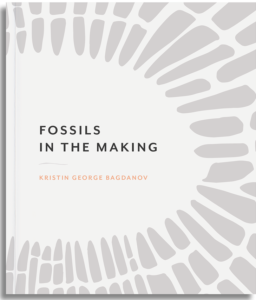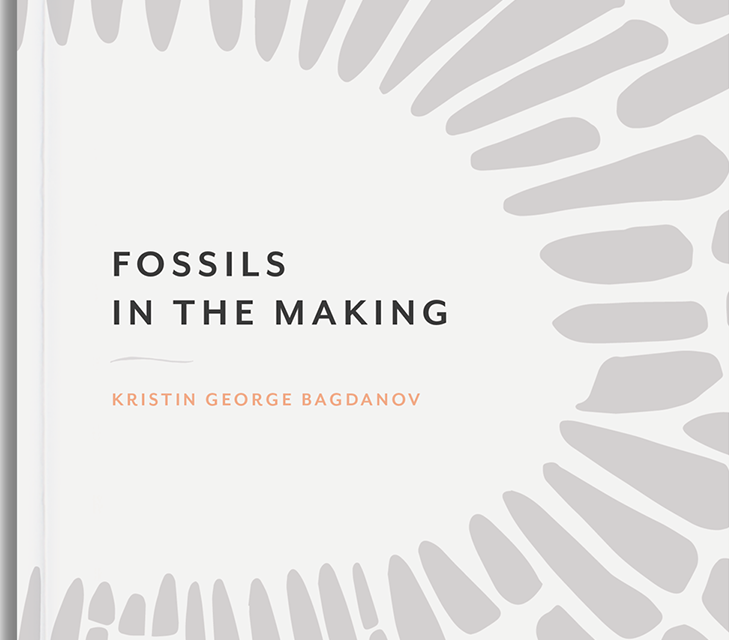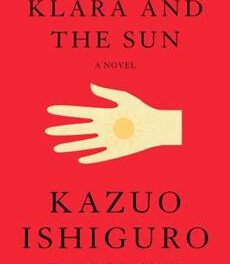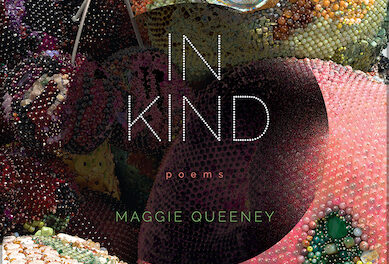Assistant Editor Madeleine Wattenberg: In the middle of the Northern Pacific Subtropical Gyre floats the Great Pacific Garbage Patch. This “trash island” consists of various debris, mostly broken down to microplastics, carried by four currents to the gyre’s center. In Kristin George Bagdanov’s debut full-length poetry collection Fossils in the Making (Black Ocean, 2019) it is no coincidence that “gyre” rhymes with “lyre.” In the collection’s opening poem, Bagdanov writes:
Our gyre / widens wider now it is plastic
Oracle that reads / in glowing teeth a future now // past
Orpheus singing into the ears of leaves / song to re / wind eternity

Different definitions of “ecopoetics” emphasize various ethical impetuses and purposes for the ecopoem. One focuses on representing the nonhuman world in order to imbue it with a renewed sense of value for the reader. But the myths of Orpheus suggest that not only is the nonhuman world listening (and I can’t help but think here of the work of Monica Gagliano on plant intelligence) but that it is altered by our songs. If language alters the nonhuman world, then we must do more than attempt to describe. Bagdanov’s poems move beyond mimetic realism as she examines the language through which we construct the nonhuman world and the ways—through hurricane, wasp sting, stone—it sings itself back.
Although Bagdanov’s individual poems continuously reward multiple readings, I suggest reading through the book in one sitting in order to hear the “echoes” across the collection. In the three sections, language is submerged only to resurface newly shaped by its surroundings. Orpheus’s leafy audience, for example, will appear again later in the poem “future / past,” which describes how traces of microplastics have been found in “birdbeak-fishbelly-breastmilk.” These poems juxtapose linear progress, an orientation toward a future horizon, against the spiraling gyre, where lyric and material forces converge: “I will not rehearse the after, the re- [/] weaving that makes each day a new pattern [/] to die upon,” she writes.
The collection addresses ecopoetics’ fundamental questions—how does language touch the material world? What role does the lyric play amid oil spills, melting glaciers, factory-farm produced algae blooms? And where does one body begin and another end? Bagdanov’s poems offer several methods of inquiry as she draws on, and just as often rejects, the vocabularies of science, math, and philosophy.
As it dismisses a purely mathematical analysis, the poem “Proof of Parasite” reminds us that nonhuman nature is not inherently passive or nurturing: “Inside a caterpillar’s belly the female wasp buries her eggs . . . labor can be exploited even in nature.” The poem begins with geometry (“Geometry compels conclusion”) and then moves, after a key shift to second person, to a reflection on motherhood: “It is impossible to prove impossible [/] to measure the distance between membrane and mother.” The poem questions motherhood as a “natural” state: “even in nature many do not want to be mothers.”
Finally, the poem turns to speech: “you become [/] in their mouths [/] what you never were [/] yourself.” This may be read literally, the caterpillar is consumed by what births inside her, but the statement also raises a question: is it possible to become what you are not? The simple answer in these poems is yes, whether it is transformation through imposed language or through material decomposition. The self is unstable. Additionally, the image of the caterpillar pregnant with the wasp’s offspring hauntingly mirrors images in other poems where microplastics and pesticides destroy bird eggs from the inside out. If humans are unwilling to raise what we produce, then something somewhere will take up the responsibility. In turn, this destabilizes the symbol of children as the future: “The dream of children but also the fear [/] that nothing is / disposable, because nothing can be.”
Bagdanov does emphasize the importance of attempt. In an acrostic poem, she buries the phrase “Lyre, I tried” amid a repetition of the word “dichlorodiphenyltrichloroethane.” DDT was banned by the United States following the publication of Rachel Carson’s Silent Spring, which offers an example of environmental writing leading to change. But the efficacy of the lyre is far from guaranteed:
If sound could save
we’d press fire
into lyre, quake
into wake
Each held
brief
by a body
known only after
by its trace
While many of these poems assert a molecular connection between all nonhuman and human bodies, Bagdanov is careful to not erase the way bodily difference has material consequences for environmental justice. She recognizes that those most affected by environmental crisis are often those least likely to receive help in its wake and that so long as climate refugees are nonwhite bodies our systems will not answer to them. The poem “Proof of Harm” acknowledges this:
This one measures the speed of sound against the body
when one person calls for help
vs. another
when one is told to raise their hands
when one is asked to raise their hand and is called on
and asked to answer
vs. told to answer for
their body
Here, sound becomes a function of racism, sexism, and classism, and “having / to imagine,” so different from having to experience, a mark of privilege.
Yet sound also closes the gap between language and body. Sound is bodily—it is produced only when vibrations travel through matter. In this way, it’s no wonder plants can “hear” us.
The final poem, fittingly named “echo / o” turns on its internal sounds; “o” is, after all, the symbol for Oxygen, the gyre’s center, the mark of invocation. The invocation is to anyone—or anything—that is listening. Bagdanov encourages us to make our attempts but also recognize that these attempts are folded within other bodies, that we both carry and are carried by the gyre’s currents. And if our making is an undoing, then perhaps our undoing will be our making too.
You can read an excerpt of the poem “fossils / making” under the title “Resurrection Body” in Issue 12.2 of Cincinnati Review.
*I have included brackets to indicate line breaks throughout so as to preserve lines that include internal slashes.
Madeleine Wattenberg is a third-year PhD student at University of Cincinnati in English and Comparative Literature. Her poems have recently appeared in journals such as The Rumpus, Puerto del Sol, sixth finch, DIAGRAM, Ninth Letter, Guernica, and Best New Poets. She graduated with her MFA in poetry from George Mason University. She regularly writes reviews for The Bind. You can follow her @topazandmaddy.











